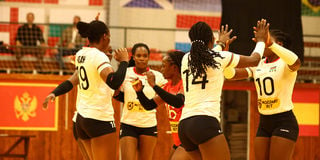All female coaches deserve a chance to handle Kenyan teams

Kenya women's volleyball team players celebrate a point during their friendly match against Red Star Belgrade at Kovilovo Sports Centre on September 17, 2022.
What you need to know:
- Wildcats is about a woman who coaches a men’s NFL team, and the implication is that such an endeavour equates to doing the undoable.
Near the end of the trailer for Wildcats, a 1986 sports comedy you can watch on YouTube, a voice actor narrates that during the film, “Goldie Hawn tackles the impossible.”
Wildcats is about a woman who coaches a men’s NFL team, and the implication is that such an endeavour equates to doing the undoable.
Sadly, that disembodied voice from the mid ’80s is still relatable today. Kenya’s national women’s volleyball team is in Amsterdam for the FIVB World Championships and there are exactly zero women working as coaches in that team!
It brings to mind the stubborn question of why women continue to be kept out of coaching roles at all levels of sport.
The picture of the battalion of eight male coaches standing over Malkia Strikers in the team’s most recent portrait, yet we have a number of trained female volleyball coaches, only fuels the traditional gender clichés surrounding women and leadership, and reinvigorates the historical assumption that sports was created for men.
I know that coach Luizomar de Moura and his assistants were seconded for Kenya by FIVB, but even so, the promotion of female coaches is an international issue.
At the last four Olympic Games, only 11 per cent of coaches were women. It means that regardless of ability, talent, or potential outcomes, and irrespective of where she comes from, a woman who aspires to lead an adult elite team is reaching for the near impossible.
Perusing data on women’s sports from various sources, what strikes me is the fact that the image of the coach as a male figure endures even in this age.
Stadium attendance for women’s games is rising, and the general culture around gender and sport is improving, but the extent to which men still dominate the women’s game remains high.
One thing that could help is bigger media presence for women, and stronger female coaching networks.
Also add better working conditions, such as full-time contracts, overtime regulations and further education opportunities, because careers in coaching are generally not the most secure, nor are they particularly family-friendly.
Imagine a woman with young children training in the evening, and having competitions at the weekend, yet they are not permanently employed. As we have seen time and again, without equal opportunities to lead, women don’t.
Another solution? The Rooney Rule, which was adopted by the NFL a few years ago. The policy requires teams to interview ethnic-minority candidates for coaching and other team operations.
Adopting this type of rule that includes female candidates, along with setting objective criteria for selecting coaches, would help increase gender diversity.
And lastly, when the women get to the top, let’s go easy on the sexist ‘banter’. This idea that when a woman doesn’t lead well, it is evidence that women can’t lead, but when a man doesn’t lead well, he wasn’t the right fit, belongs in the past.
That perception must change because it makes the few women coaches working in high profile teams feel like they need to be twice as good, often while working twice as hard.





